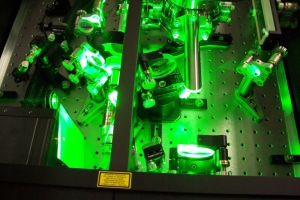- Home
- Users & Science
- Find a beamline
- Complex systems and biomedical sciences
- ID09 - White Beam Station - Time-resolved Beamline
- ID09 Laser sources
- femtolaser
- Description of the femtosecond laser system
Description of the femtosecond laser system
Femtosecond system general description:
Recently (March 2006) the femtosecond laser system has been upgraded. The new system should deliver 2.5 mJ per (100 fs) pulse with a maximum repetition rate of 3 kHz. The manifacturer is KMlabs.
The femtosecond laser is the main instrument for ultra fast initiation of photo-chemical reactions. It is phase locked to the x-rays and used for single-bunch Laue diffraction, stroboscopic experiments up to 1 kHz (diffraction and wide-angle scattering) and to trigger a jitter-free femtosecond x-ray streak camera.
The laser system consists of three stages.
A laser pulse contains more than 3 x 1013 photons, which matches the number of binding sites in a 100 x 100 x 100 um3 MbCO crystal or the number of absorbers in a few mM solution (100x100x300 um3. This pulse energy makes it possible, at least in principle, to produce a high degree of excitation. In practice one would like to have more photons to compensate for losses in the beamline between the laser and the sample. The laser is focused by a motorised telescope, which makes it possible to scan the laser focus onto the sample.
Performance:
| wavelength(nm) | energy(eV) | energy(uJ/pulse) | ph/pulse | |
| 1st harmonics | 800 | 1.55 | 1500 | 6.0e+15 |
| 2nd harmonics | 400 | 3.10 | 450 | 9.0e+14 |
| 3rd harmonics | 267 | 4.64 | 75 | 1.1e+14 |
| OPG/OPA | 650 | 1.90 | 200 | |
| OPG/OPA | 500 | 2.48 | 180 | |
| OPG/OPA | 325 | 3.80 | 44.4 |





